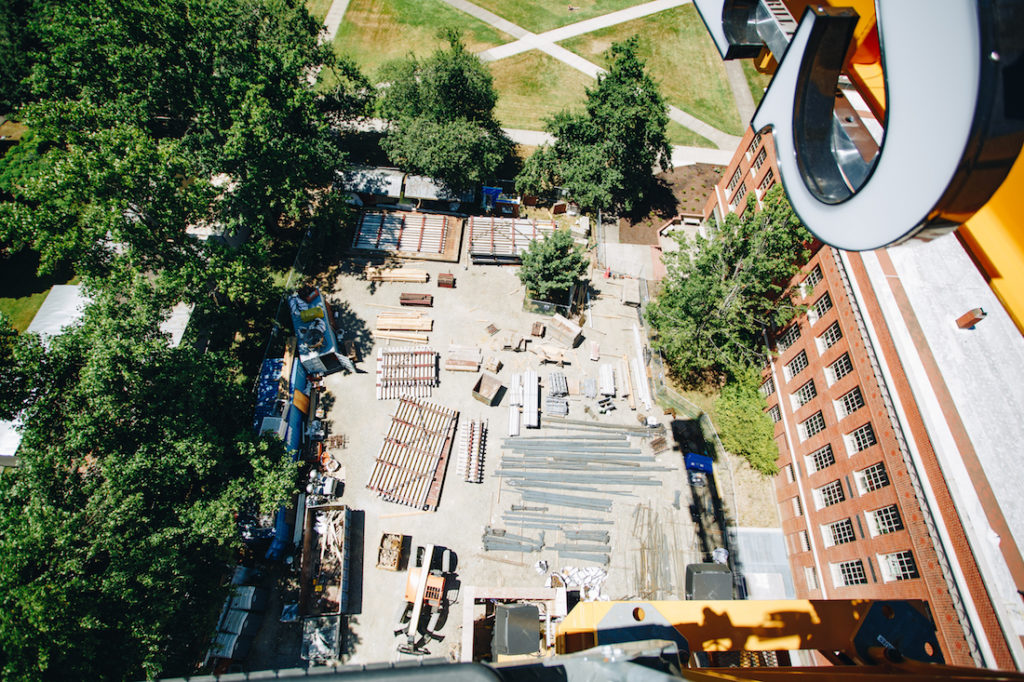Tykeson Hall's Crane Featured in the Daily Emerald
(Sarah Northrop/Emerald)
Meet UO’s campus crane operator
By Zach Prince
The Daily Emerald
July 30, 2018
Perched far above the claustrophobic PLC offices, looming over the infamous steps of Johnson Hall, sits a 172 EC-B Liebherr tower crane. Standing at more than 200 feet in the air, the view from the crane’s cab might be one of the best in town. On a clear day, one can see everything from Eugene’s east hills and Hendricks Park to the city’s tallest building, the Ya-Po-Ah Terrace.
Sitting atop the swaying beast is Ray McArthur, who is tasked with operating the crane for Nesscampbell, a Northwest-based crane and rigging company. McArthur, 63, has worked as a crane operator for more than 30 years and operated cranes for numerous construction projects on both the University of Oregon and Oregon State University’s campuses.
In Eugene, Ray McArthur operated cranes for the construction of Matthew Knight Arena, the EMU’s renovation, student housing, Autzen Stadium’s renovation, the Casanova extension, The Rec and the Jordan Schnitzer Museum of Art. (Sarah Northrop/Emerald)
In Eugene, McArthur operated cranes for the construction of Matthew Knight Arena, the EMU’s renovation, student housing, Autzen Stadium’s renovation, the Casanova extension, The Rec and the Jordan Schnitzer Museum of Art. He also worked on multiples projects at OSU including Reser Stadium and a science building. He is currently working on the Tykeson Hall construction project, which is scheduled to open in the fall of 2019.
McArthur, who lives in Pleasant Hill, Oregon, is a seasoned tower crane operator who portrays a surprising amount of calmness despite using such heavy machinery. But that wasn’t always the case.
“I used to seriously have to sit with two rags on my legs,” McArthur said. “I’d rub my hands on them just ‘cause I’d sweat that much.”
McArthur worked as a laborer in the construction industry for 10 years before he became involved in operating heavy machinery. He first started out operating boom trucks, then hydro cranes and continued to move into working with larger equipment as time went on. The first time he operated a crane was when a construction site superintendent asked if he would cover for the site’s tower operator, who had gone on vacation for the week.
“[The superintendent’s] operator in Portland was going to go deer hunting or something, so he wanted to know if I would cover for him,” McArthur said. “I had never been in a tower crane before so I said ‘Hell yeah, let’s do it.’”
There was no required training or necessary qualifications for operating tower cranes when McArthur first began operating in the 1980s. Now there is a five-year apprenticeship required to break into the profession.
On his first job, the site superintendent promised McArthur a week-long training session from the regular operator. After not finding time to go up in the crane on either Monday or Tuesday, the two finally made it up on Wednesday for a two-hour training session. The operator then told McArthur they would pick up where they left off the next morning, but that isn’t how it happened.
“Thursday morning, I’m waiting for the operator to show up to give me some more instruction,” McArthur said. “So I’m looking around, looking around and the son of a gun never came back in. Two hours of training and then the thing was in my lap. Talk about being scared.”
McArthur was thrown into the fire on his first crane operating job, but even after two decades of experience, he still considers his profession stressful.
“It gets pretty intense sometimes,” McArthur said. “I didn’t have grey hair before I started this job.”
The level of stress McArthur regularly experiences depends on factors such as the weather conditions, how much work there is and what type of work needs to be completed.
McArthur says the best way to avoid those stressful situations is good communication. Groundworkers communicate with the crane operator by using a combination of radio messages and hand signals. On large construction sites, operators work with a bellman who serves as eyes on the ground, but for smaller sites such as Tykeson Hall, McArthur is on his own.
In order to work safely and effectively, operators must build a trust with the workers on the ground, McArthur said. This is especially true when the crane is operating in a blind spot that McArthur can’t see.
“If I can see it, I don’t sweat it,” McArthur said, “but if I can’t see it, if I’m picking stuff out of the basement or way over there where I can’t see, then those guys are running the crane, basically. I’m just doing what they tell me to do.”
Luckily, McArthur knows most of the other workers on the Tykeson Hall site, which gives him insight on who to trust and who to keep a closer eye on.
McArthur thought that Tykeson Hall would be his last job before retirement, but he’s a motorhead and couldn’t resist making an investment in a classic Chevy Nova last fall. Instead of retiring, he will operate the tower crane for the Knight Science Campus construction project, which broke ground in March 2018.
But for McArthur, delaying his retirement plans isn’t such a bad thing. Despite the stress that can come with being a crane operator, he truly loves the work he has made a career out of.
“I like the guys I work with. I like the challenge because every day is a challenge,” McArthur said. “Every day is something different. It’s not the same thing every day.”
For the full photo gallery, see "Photos: Climbing the campus crane" by Sarah Northrop.







